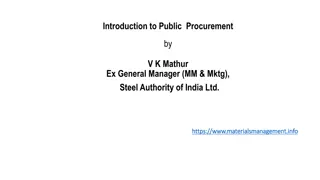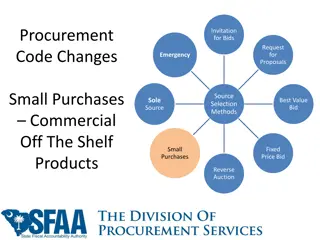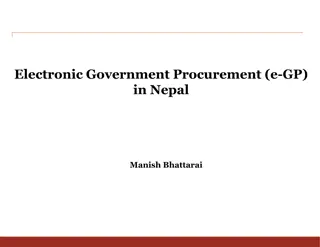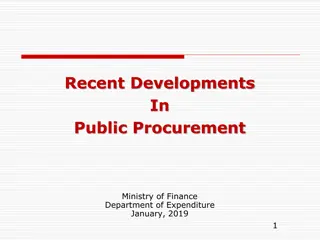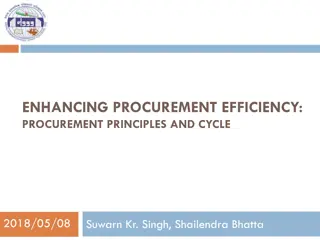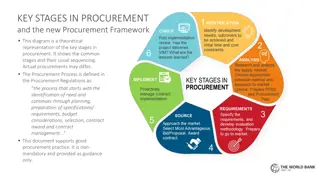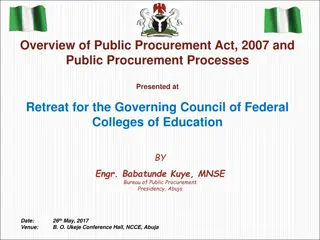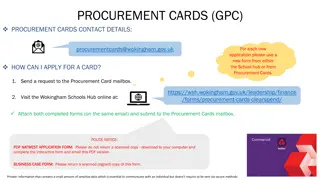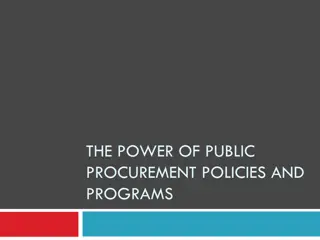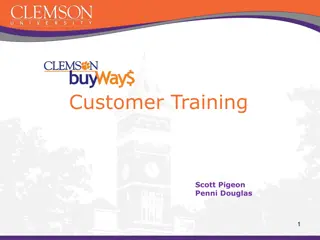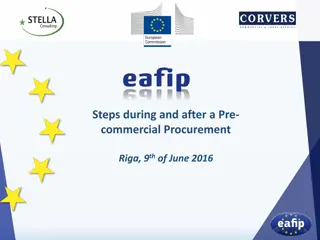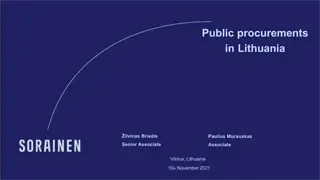Understanding Procurement in Project Management
Procurement involves acquiring products, services, or tools from external sources. The goal is to determine project needs and make decisions on what, how, and when to procure. Techniques like subject matter expert input and make-or-buy analysis help in this process. Consideration of costs, risks, and make-or-buy decisions are crucial in procurement for project success.
Download Presentation

Please find below an Image/Link to download the presentation.
The content on the website is provided AS IS for your information and personal use only. It may not be sold, licensed, or shared on other websites without obtaining consent from the author. Download presentation by click this link. If you encounter any issues during the download, it is possible that the publisher has removed the file from their server.
E N D
Presentation Transcript
Procurement means acquiring or purchasing products, systems, tools, applications, and/or services from an outside/external source Experts predict that global spending on computer software and services will continue to grow. India is the leading country for U.S. offshore outsourcing.
The key goal of this process is to determine which project needs may best be met by sellers or vendors outside of the project team. It includes deciding: whether to procure or not how to procure what to procure how much to procure when to procure Techniques: 1.1. Subject Matter Experts both internal and external, can provide valuable inputs in procurement decisions 1.2. Make-or-buy analysis determine whether it makes more sense to perform the activities within the project team or to contract with a seller.
Assume you can lease an item you need for a project for $800/day. To purchase the item, the cost is $12,000 plus a daily operational cost of $400/day. How long will it take for the purchase cost to be the same as the lease cost? Information Technology Project Management, Fourth Edition 7
Set up an equation so both options, purchase and lease, are equal. In this example, use the following equation. Let d be the number of days to use the item: $12,000 + $400d = $800d Subtracting $400d from both sides, you get: $12,000 = $400d Dividing both sides by $400, you get: d = 30 If you need the item for more than 30 days, it is more economical to purchase it. Information Technology Project Management, Fourth Edition 8
Labor costs : internal cost of human resources Human resource knowledge : if required knowledge is not present training will be needed Cost to prepare and maintain all product artifacts (progress reports, testing, schedules, etc.) Rework costs : costs of changes, bugs On-going support costs day-to-day maintenance and updates after product/service is implemented Opportunity costs while working on this project, other items are not getting done Cost associated with the procurement process itself Cost to manage the relationship Initial purchase cost along with on-going support costs Other Risks (associated with the vendor itself) Make-or-Buy Decision: MAKE option Make-or-Buy Decision: BUY option
Statement of Work (SOW) is a contract between the Software Development/IT staff and the customer regarding deliverables and time estimates for a software system/IT system development project. SOW is a document which describes the procurement item in sufficient detail to allow prospective sellers to determine if they are capable of providing the item and potentially at what cost SOW is a document which describes 100% of the work or services required to be completed under contract by the seller Information Technology Project Management, Fourth Edition 10
I. Scope of Work: Describe the work to be done to detail. Specify the hardware and software involved and the exact nature of the work. Location of Work: Describe where the work must be performed. Specify the location of hardware and software and where the people must perform the work Period of Performance: Specify when the work is expected to start and end, working hours, number of hours that can be billed per week, where the work must be performed, and related schedule information. Deliverables Schedule: List specific deliverables, describe them in detail, and specify when they are due. Applicable Standards: Specify any company or industry-specific standards that are relevant to performing the work. Acceptance Criteria: Describe how the buyer organization will determine if the work is acceptable. Special Requirements: Specify any special requirements such as hardware or software certifications, minimum degree or experience level of personnel, travel requirements, and so on. II. III. IV. V. VI. VII. Information Technology Project Management, Fourth Edition 11
Contracts : The seller/buyer relationship is based on a signed contract = a mutually binding agreement entered into by two or more parties enforceable in a court of law. It obligates the seller (provider, developer) to provide the specified products, services, or results. It also, obligates the buyer (customer) to provide in most cases monetary compensation Contracts generally fall into one of three broad categories: Type 1: Fixed-price or lump-sum Type 2: Cost-reimbursable Type 3: Time and material
Contract that provides for a price which normally is not subject to any adjustment unless certain provisions (such as contract change, economic pricing, or defective pricing) are included in the agreement. These contracts are negotiated usually where reasonably definite specifications are available, and costs can be estimated with reasonable accuracy. A fixed price contract places minimum administrative burden on the contracting parties, but subjects the contractor to the maximum risk arising from full responsibility for all cost escalations. Also called firm price contract. A fixed-price or lump-sum contract is appropriate when the Statement of Work (SOW) is sufficiently detailed and stable such that the seller can prepare an accurate fixed price for completing the work The seller is obligated to complete 100% of the work at the negotiated (fixed-price) contract value Unfortunately, this method presents risks for both buyer and seller. Why?
This category involves the reimbursement (payment) of the seller s actual costs, plus a fee typically representing the seller s profit. Cost-reimbursable contracts include incentive (motive, stimuli) clauses based on the seller meeting certain project objectives such as schedule targets or cost targets 2.1. Cost-plus-fee or cost-plus percentage of cost 2.2. Cost-plus-fixed fee 2.3. Cost-plus-incentive fee (stimulus)
Cost plus percentage of costs (CPPC): The buyer pays the supplier for allowable performance costs plus a predetermined percentage based on total costs. Cost plus fixed fee (CPFF): The buyer pays the supplier for allowable performance costs plus a fixed fee payment usually based on a percentage of estimated costs. Cost plus incentive fee (CPIF): The buyer pays the supplier for allowable performance costs plus a predetermined fee and an incentive bonus.
For example: a project that was originally estimated to cost $50,000 was also given a fixed fee of $10,000. If the project was completed by the Seller at greater cost (for example, at a cost of $60,000), then they would only receive $60K + $10K + ($50K - $60K) = $60,000 or $ 0.0 profit If the project was completed by the Seller at lower cost (for example, at a cost of $45,000), then they would receive $45,000 + $10,000 = $55,000 or $ 10K profit
Example # 1: Sharing Formula 85/15, 85% by buyer and 15% by seller Allowable cost $50,000 Target Fee $3,750 Maximum Fee $6,750 Minimum Fee $1,500 Project Result: Seller completes the project at cost of $45,000 Seller is paid $45,000 + ($50,000 $45,000) * .15 + $3750 = $49,500 Seller profit = $49.500 - $45,000 = $4,500
Example # 2 Sharing Formula 85/15 Allowable cost $50,000 Target Fee $3,750 Maximum Fee $6,750 Minimum Fee $1,500 Project Result: Seller completes the project at cost of $55,000 Seller is paid: $55,000 + $1,500 = $56,500 Seller profit = $1,500
Information Technology Project Management, Fourth Edition 19
Requesting seller responses: Obtaining information, quotes, bids, offers, or proposals from sellers, as appropriate. Selecting sellers: Choosing from among potential suppliers through a process of evaluating potential sellers and negotiating the contract. Administering the contract: Managing the relationship with the selected seller. Closing the contract: Completing and settling each contract, including resolving any open items. Information Technology Project Management, Fourth Edition 20
Involves preparing several documents needed for potential sellers to prepare their responses and determining the evaluation criteria for the contract award. Request for Proposals: Used to solicit proposals from prospective sellers. A proposal is a document prepared by a seller when there are different approaches for meeting buyer needs. Requests for Quotes: Used to solicit quotes or bids from prospective suppliers. A bid, also called a tender or quote (short for quotation), is a document prepared by sellers providing pricing for standard items that have been clearly defined by the buyer. Information Technology Project Management, Fourth Edition 21
Also called source selection. Involves: Evaluating proposals or bids from sellers. Choosing the best one. Negotiating the contract. Awarding the contract. Information Technology Project Management, Fourth Edition 22
Information Technology Project Management, Fourth Edition 23



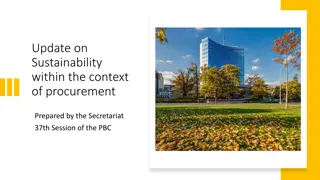
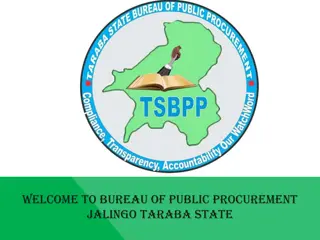
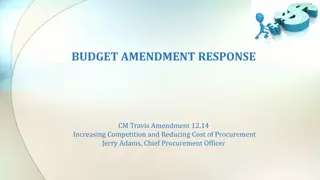
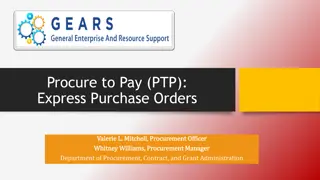
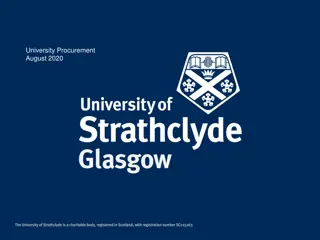
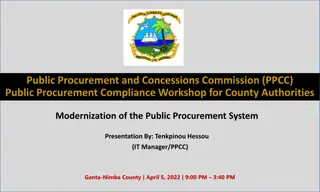
![Comprehensive Overview of Corruption Watch Submission on Public Procurement Bill [B18B-2023]](/thumb/138344/comprehensive-overview-of-corruption-watch-submission-on-public-procurement-bill-b18b-2023.jpg)
